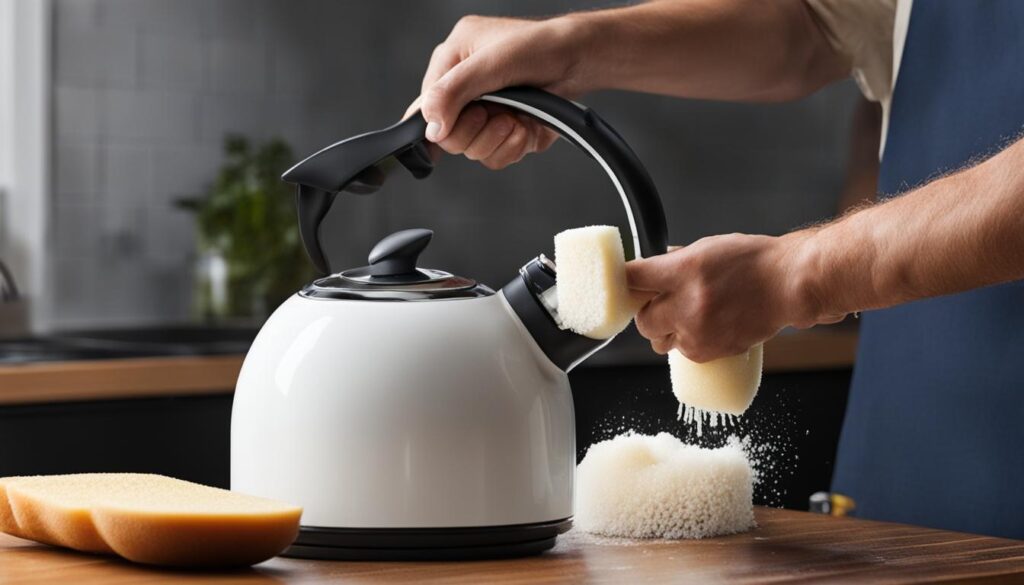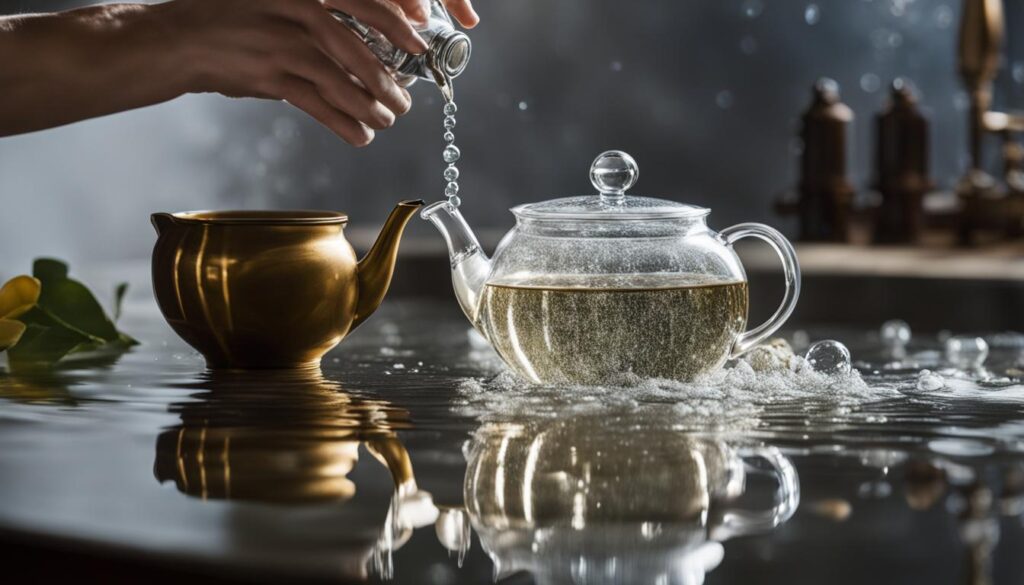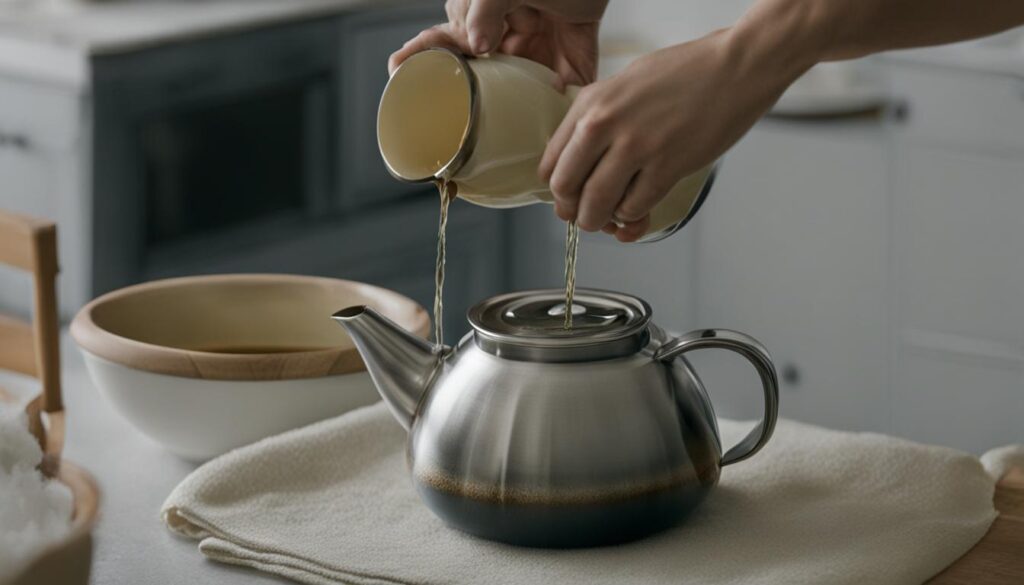
Keeping Your Tea Equipment Pristine: Cleaning and Maintenance Tips
Welcome to our guide on maintaining tea brewing equipment. As tea enthusiasts, we understand the importance of keeping your tea gear in pristine condition to ensure the best flavor and freshness in every cup. In this article, we will share some valuable tips and tricks for cleaning, caring for, and sanitizing your tea equipment.
Key Takeaways:
- Regularly clean and maintain your tea brewing equipment for optimal flavor and freshness.
- Use appropriate cleaning products designed specifically for tea equipment.
- Familiarize yourself with effective sanitizing methods to keep your tea gear hygienic.
- Follow care instructions for specific types of tea equipment, such as glass teapots and stainless steel teapots.
- By incorporating regular cleaning and maintenance into your tea routine, you can extend the lifespan of your tea equipment and enjoy the perfect cup of tea every time.
How to Clean an Electric Kettle for Perfect Tea Brewing
Regular cleaning and maintenance of your electric kettle is essential to ensure the best possible flavor in your tea. One common issue with electric kettles is the buildup of limescale, which can affect the taste of your hot beverages. To descale your electric kettle, a simple and effective method is to use vinegar.
Descaling Electric Kettles: Fill the kettle with a mixture of equal parts white vinegar and water. Bring the solution to a boil and let it stand overnight. The acidic properties of vinegar will help dissolve the limescale buildup. In the morning, rinse the kettle thoroughly with clean water to remove any vinegar residue.
Cleaning Electric Kettle with Vinegar: Vinegar is a natural cleaning agent that helps remove mineral deposits and disinfect the interior of the kettle. Its acidic properties make it effective for breaking down limescale. However, it’s important to note that vinegar can leave behind a strong odor. To get rid of the vinegar smell, boil clean water in the kettle once or twice and discard the water before using the kettle for brewing tea.
Removing Buildup in Electric Kettle: Regular cleaning of your electric kettle can prevent the buildup of limescale. After each use, rinse the kettle with warm water and wipe the exterior with a damp cloth. This will help keep your electric kettle looking pristine and ensure the longevity of its performance.

A clean and well-maintained electric kettle not only ensures better-tasting tea but also prolongs the lifespan of your appliance. By regularly descaling and cleaning your electric kettle, you can enjoy the perfect cup of tea every time.
Tips for Cleaning and Caring for Glass Teapots
Glass teapots add an elegant touch to your tea brewing experience, but they require special care to maintain their pristine appearance and avoid residue or stains. To keep your glass teapot looking its best, follow these cleaning and care tips:
Cleaning Process
After each use, rinse the teapot and spout with warm water to remove any loose tea leaves or residue. Then, hand wash all parts with a mild dish soap and warm water, ensuring thorough rinsing to remove any soap residue. Avoid using abrasive cleaning tools or harsh chemicals, as these can scratch or damage the glass surface. Instead, use a soft sponge or cloth to gently clean the teapot.
Preventing Soap Residue
To prevent soap residue from affecting the taste of your tea, make sure to rinse the teapot thoroughly after washing. It’s recommended to rinse with warm water for several minutes, ensuring all traces of soap are removed. If you notice any soap residue, repeat the rinsing process until the teapot is completely clean.
Care Instructions
Proper care is essential to maintain the beauty and longevity of your glass teapot. Here are some care instructions to follow:
- Avoid using glassware that is chipped or cracked, as it may break during use.
- Never expose a glass teapot to sudden temperature extremes, as this can cause the glass to crack or shatter.
- Avoid using a glass teapot in the microwave, as it is not designed to withstand high heat.
- Store your glass teapot in a safe place where it won’t be subjected to accidental bumps or falls.
By following these cleaning and care tips, you can ensure that your glass teapot remains in optimal condition, allowing you to enjoy a visually appealing and delicious cup of tea every time.

Cleaning a Badly Stained Stainless Steel Teapot
Stainless steel teapots are a popular choice for tea lovers due to their durability and sleek design. However, over time, these teapots can develop stubborn stains that can be challenging to remove. Fortunately, there are natural cleaning methods you can use to restore the shine of your stainless steel teapot without causing any damage.
One effective method for removing stains from a stainless steel teapot is using baking soda. Create a paste by mixing baking soda with water until it forms a thick consistency. Apply the paste to the stained areas of the teapot and gently scrub with a soft cloth or sponge. The mild abrasive properties of baking soda help to lift and remove stains without scratching the surface of the stainless steel. Rinse the teapot thoroughly with warm water and dry it with a clean cloth to reveal a sparkling, stain-free surface.
Another natural cleaning method involves the use of white vinegar. Fill the teapot with a mixture of equal parts water and white vinegar, and let it sit for a few hours or overnight. The acidity of the vinegar helps to break down mineral deposits and stains. Afterward, scrub the teapot gently with a soft brush and rinse it thoroughly. Be sure to remove any vinegar odor by rinsing the teapot with clean water. This method is particularly effective for removing hard water stains and giving your stainless steel teapot a renewed shine.
When cleaning a stainless steel teapot, it is important to avoid using abrasive pads or steel wool, as they can scratch the surface of the teapot. Additionally, take precautions to prevent scratches by using non-abrasive cleaning tools and avoiding contact with sharp objects. By following these cleaning methods and taking proper care of your stainless steel teapot, you can keep it looking pristine and enjoy many cups of delicious tea for years to come.

Table: Natural Cleaning Methods for Stainless Steel Teapots
| Cleaning Method | Ingredients | Instructions |
|---|---|---|
| Baking Soda Paste | Baking soda, water |
|
| Vinegar Soak | White vinegar, water |
|
Conclusion
Maintaining your tea brewing equipment is essential for extending its lifespan and ensuring the perfect cup of tea every time. By following a regular maintenance schedule for your tea gear, you can keep it in pristine condition and enjoy optimal flavor and freshness in your favorite brews.
Regular cleaning and descaling of electric kettles, glass teapots, and stainless steel teapots are key to preventing staining and buildup. Not only will this extend the lifespan of your tea equipment, but it will also enhance the taste and aroma of your teas.
When it comes to cleaning your tea tools, it’s important to choose environmentally friendly methods. Avoid harsh chemical cleaners and opt for natural solutions like vinegar, baking soda, and lemon juice. These gentle yet effective cleaners will remove stains and mineral buildup without damaging your tea equipment.
By incorporating these cleaning and maintenance tips into your tea routine, you can ensure that your tea equipment remains in top-notch condition for years to come. So, grab your favorite brew, give your tea gear a little TLC, and enjoy the perfect cup of tea, time after time.
FAQ
How often should I clean my tea brewing equipment?
It is recommended to clean your tea brewing equipment regularly to ensure optimal flavor and freshness in your brews. Cleaning frequency may vary depending on usage, but a general guideline is to clean your equipment at least once a week.
What is the best way to descale an electric kettle?
Descaling an electric kettle can be done effectively with vinegar. Fill the kettle with a mixture of white vinegar and water, bring it to a boil, and let it stand overnight. Rinse the kettle thoroughly before using it again. Repeat the process with clean water to remove any vinegar odor or taste.
How do I clean a glass teapot without leaving any soap residue?
After each use, rinse the teapot and spout with warm water. Hand wash all parts using soap and warm water, ensuring thorough rinsing to remove any soap residue. Dry the teapot with a soft dish towel to prevent watermarks and maintain its shine.
How can I remove stains from a stainless steel teapot?
One effective method is to create a paste using baking soda and water, apply it to the stained areas, scrub gently, and rinse thoroughly. For mineral deposits, a mixture of water and white vinegar can be boiled in the teapot, left to sit, and then scrubbed gently with a soft brush before rinsing. Avoid using abrasive pads or steel wool to prevent scratching the stainless steel surface.
How can I prolong the lifespan of my tea brewing equipment?
Regular cleaning and maintenance are key to extending the lifespan of your tea brewing equipment. Follow the recommended cleaning methods for your specific equipment, perform regular descaling, and handle your equipment with care to avoid damage. This will help keep your tea gear in great condition for years to come.






